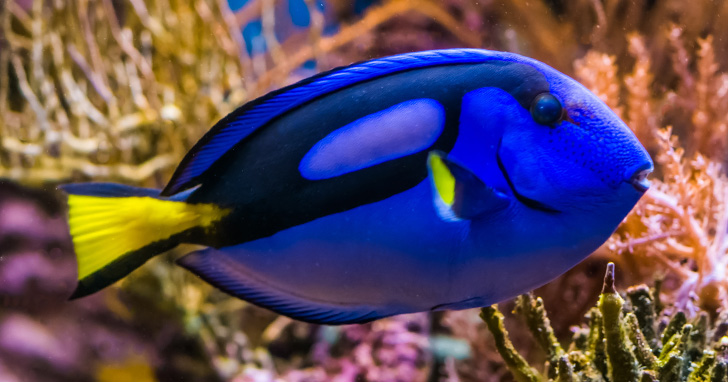
The Blue TangSo Much More Than a Movie Star! The Blue Tang Paracanthurus hepatus is primarily found in coral reef ecosystems of the Indo-Pacific region, including the waters surrounding East Africa, Indonesia, the Philippines, and the Great Barrier Reef. In addition to the ones found in nature, there are species that are tank raised. Tank raised (or captive reared) fish are those that are captured at the larval or post larval stage in nature and then grown out in protected farm and supplier fish beds. These fish are often more adaptable to home aquariums than their wild-caught counterparts. They are hardy and one of the most popular Tangs in saltwater and reef aquariums. In nature, the Blue Tang lives in large shoals because they are often attracted to a central food source, or they band together to drive away aggressors in their environment. During the mating season, however, male Blue Tangs may live among a harem. In an aquarium, it is recommended to keep only one. The Blue Tang, originally categorized as Teuthis hepatus, belongs to the Acanthuridae family. They are sought after by aquarists because of their beautiful coloration. In a brilliant blue, they display yellow on their pectoral fins and tail. Bold black markings appear on their sides that resemble the shape of an artist's palette. Blue Tangs exhibit chromatic adaptation, meaning their color can fade under stress or intensify during aggressive encounters. The Blue Tang is also known as the Pacific Blue Tang, the Palette Surgeonfish, the Regal Tang, and the Hepatus Tang. Regardless of the name they are known by this Surgeonfish has won the hearts of many marine aquarists. What do Blue Tangs need to be healthy?
Blue Tangs are popular not only because they are beautiful, but because they are hard to breed in captivity. In order to keep them healthy, pristine water quality is required, as well as the right foods. Are Blue Tangs good for beginners?
Paracanthurus hepatus have a moderate care level requiring an aquarist with experience. They require stable water conditions because they are susceptible to White Spot Disease, Lateral Line Disease, and fin erosion. Along with powerful filtration, well oxygenated water, and a protein skimmer, regular water changes are required to keep them healthy. LiveAquaria® has a host of helpful articles to help keep your aquatic life healthy. Is a Blue Tang aggressive?
They require open swimming area and access to cover. Overall, they are hardy and make good aquarium fish and should only be introduced to established systems with live rock in which it can hide. Although it is considered one of the least aggressive Tangs, suitable tankmates should still be selected carefully to reduce stress. Do Blue Tangs live with Clownfish in real life?
Blue Tangs are compatible with Clownfish. See our Marine Compatibility Chart to see who else would make a suitable tankmate for your Blue Tang. How venomous is a Blue Tang?
Blue Tangs have a venom gland that is located at the base of the caudal fin. For this reason, it is not used in the food industry because their flesh can cause ciguatera, a foodborne illness. The caution to their aquarium caretakers is really that the spines of the Blue Tang can cause painful cuts. How big do Blue Tangs get?
Blue Tangs grow to a maximum of twelve inches in length. What are the water requirements for Blue Tangs?
The temperature of the aquarium should be between 72-78° F, the specific gravity 1.020-1.025, dkH of 8-12, and a pH range of 8.1-8.4. An aquarium with a minimum one hundred eighty gallon capacity is recommended for this saltwater fish that can grow to a maximum of twelve inches. Are Blue Tangs easy to breed?
Blue Tangs have not been bred successfully in captivity, so farm raised specimens allow suppliers to meet the demands of the home aquarium industry. What do Blue Tangs eat?
This member of the Acanthuridae family is an herbivore. Although Tangs will eat meaty foods along with the other fish in the aquarium, it is important that they are offered plenty of marine based seaweed and algae. This will strengthen the Blue Tang's immune system, reduce aggression and improve their overall health. Offer dried seaweed tied to a rock or use a veggie clip, fed at least three times per week. In Closing
Regardless of the name they are known by the Blue Tang has won the hearts of both saltwater and reef aquarium owners. Tangs make wonderful additions to the reef or fish only aquarium. What are you waiting for? Fulfill that Tang dream today! Related Articles
|
|
|


